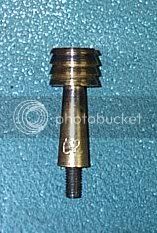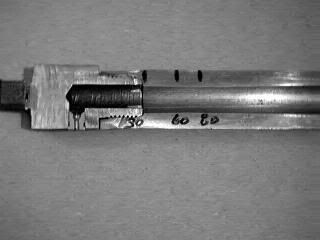CJ: Clean with cleaning patches- usually cotton flannel, but muslin, pocket drill, and other fabrics work as well, including Tow made from linen plant fibers. Save the greased patches for wrapping around the ball.
The point of cleaning between shots is to REMOVE the residue from the powder. Residue is carbon, graphite, and some traces of potassium and sulfur. The carbon and Graphite generally will make up the bulk of the residue, and the " chunks" you feel as you run a cleaning patch down the barrel.
Since you are loading and cleaning a rifle, you can use ONE SIZED cleaning jag. Its needs to be about .030"SMALLER in diameter than your bore diameter. That allows the fluffier cleaning patch to slide down OVER the dirty lands, then bunch up and fill the grooves of the jag, so that you can PULL the crud out of the barrel, from both the lands and the grooves. If your jag is a closer( tighter ) fit, all you are doing is pushing the crud down in to the breech and powder chamber.
When you clean, you will find it works better if you run the first patch down to about 1 inch above the breech, and pull out as much of the crud and residue as you can from that point. Then, when you run a second cleaning patch down the barrel Only 1 inch of crud is going to be pushed in front of the jag and cloth patch, leaving much less crud down on the breech. I use a damp patch for my first two swipes, then a dry patch to follow to remove any moisture I might have put in the barrel. I feel that patch when its comes out of the barrel to feel how damp it is. If its WET, I run a second dry cleaning patch down the barrel, to dry the barrel thoroughly before pouring in the next powder charge. Humidity is EVERYTHING you have to consider when loading and cleaning your MLer. Be prepared to get your hands dirty. At the range, I have towels, water, and soap to wash my hands off, or wipe the crud off during a shoot. When hunting, I have that stuff back at the car. I fire a lot more shots at the range than I ever have on my best day of shooting doves, which have the highest daily bag limit of any hunting game in my state. I can wait to wash my hands when I get back to the car. However, I do take a hand towel with me into the dove fields, to wipe my hands and wipe the sweat out of my eyes.
I believe your gun has a smaller diameter powder chamber. Most are about .32 caliber in size. You can clean them with a .30 caliber brush, or cleaning jag. If you push crud ahead of the cleaning jag into the chamber, it will eventually clog up enough to prevent powder getting down into it for ignition. With any flintlock, you want some powder in the barrel to be close to the vent hole, for good ignition. With some of the Nock style breeches, there is a flash channel that goes from the vent hole to the back of the powder charge. The distance is not great, but if NO powder gets down into that flash channel you can get misfires.
Remove the clean out screw on the side of the bolster, and visually inspect that flash channel. It should not only be clear of debris, grease, and dirt, but it should be very smooth. Sometimes they are rough, and any rough surface will catch and hold onto residue, eventually blocking passage of powder, or heat. Misfire is the result. Use a drill bit and/or reamer to smooth that flashchannel out. If you have to widen the flash channel to get it smooth, don't worry about that. Do it. Clean that flash channel after each shoot with a pipe cleaner, and some solvent. If you pump solvent and soap and water through the breech, usually the higher pressure created by pushing the wider column of soap and water down through the narrower flash channel and out the vent, will clean the flash channel, too. The, a pipe cleaner is only used to DRY the flash channel.
Some smiths take those breeches out of the gun and drill open the powder chamber to bore diameter, so that you can clean the " chamber " with the same patch and jag you use to clean the rifling.
This is a foreign made gun. Warranties are about useless for these guns. If your gun continues to give you problems, do whatever it takes to make it work, or trade it for a U.S. made gun. The factory is not governed by U.S. laws on warranty, no matter what any tags might say on the new guns.
YOur current problem stems from using the wrong cleaning technique. Get some flannel cleaning patches and use only them to clean the barrel. That will pull the crud out, and should let you fire the gun without concern that your cleaning technique will cause a misfire. :thumbsup:







